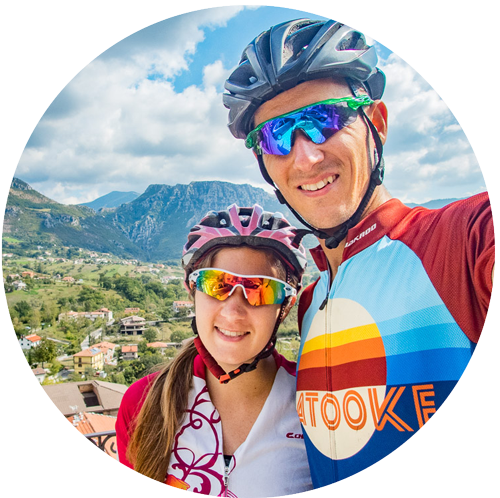How to Pack a Tandem Bike for Travel
***This post may contain affiliate links.***
* This post contains some affiliate links. By purchasing a product or service through these links you are helping to support this blog at no extra cost to you. We only recommend products we personally use and love!
We love to travel by tandem bike, both for transportation and simply for the joy of riding.
How is it possible to travel with a tandem bicycle?
This is the most common question we get asked when we tell people that we travel with a tandem. Yes, it is big. Yes, it is heavy. But yet, we still travel with it.
There have been innovations in bicycle design that allows them to come apart more and more and to even fit into airline regulation sized luggage (62 linear inches). I designed our titanium tandem around a specific case for it to fit in, made by S&S Machine. They are the original designer of the S&S Coupling or Bicycle Torque Coupling. All of their bike designs are centered around fitting your bike inside a 26″x26″x10″ case. The premise of the S&S Coupling design is to allow a normal, full-sized bike with 26″ or 700c wheels to fit inside an airline regulation sized case.
Our case of choice is the S&S Backpack Travel Case seen below. This case allows our full tandem including racks and fenders to fit inside and travel. Granted it is very heavy once fully inside the case, however, it allows us to travel with the tandem and do point-to-point trips carrying the case with us on the bike.

 How the tandem fits inside
How the tandem fits inside

First step to packing the bike is to take it fully apart. Almost everything has to come apart on the bike in order for it to fit.
- The wheels are removed and quick releases removed from the wheels. The cassette can stay on the wheel. Disc rotors must be removed or they will bend and be useless. Air must be released from the tires or the will not fit.
- All water bottle cages are removed from the frame. If you do not do this, they will be torn apart during transport.
- Kickstand must be removed.
- Racks must be removed. Pro tip: Put the bolts with washers and spacers back in the bolt holes on the bike, so you remember where they all go.
- Cranks must be removed, but the pedals can stay attached to the crank arms.
- Handlebars must be removed. The stem stays attached to the captain’s bars and the stoker’s stem stays attached to the seat post.
- Seat posts must be removed, but saddles and stoker’s stem stay attached. Pro tip: Mark seat post location using electrical tape and it will slide down and stop in the correct spot upon reassembly.
- Chains must be removed. The rear chain has to be split to remove from the bike.
- Rear derailleur has to be taken off. Try to not remove the cable or you will have to readjust it when you arrive.
- Cables must be detached. We use cable splitters that screw together to make this very easy. We have made it so the rear derailleur cable and housing comes off with the rear derailleur.
- Fork may or may not have to be removed. Our front triangle is a 56cm frame size, so the fork must be removed, but if you have a smaller front cockpit, the fork can stay attached. The front brake must be removed from the fork in order to remove the fork.
1. Place the front triangle on the bottom and place the rear wheel, cassette side down, into the case. The tires must be deflated in order to fit inside a 26×26 in square.

2. Place the rear triangle in next. You have to align the wide part at the rear dropouts with the open spot left from the front triangle underneath. The rear wheel will be canted inside the case allowing the wide rear dropout to fit inside the case. This is crucial to understand or you will struggle for hours to get the case to close.

3. The rear rack fits in around the wheel. The wheel has to be lifted up to allow the rack to fit around it and underneath the frame.

4. The 2 tubes that connect the rear triangle to the front triangle are inserted between the rack and rear wheel. These really can be put in anytime as they are small parts that just have to be squeezed in with everything else.

5. The fork is slid in between the rear triangle.

6. The captain’s handlebars are inserted with the drops around the rear wheel. This time was just around the rear wheel with one side, but I usually try to get both fully around the rear wheel.

7. Insert cranks wherever you can find room for them. One is under everything, and one is next to the rear wheel.

8. The stoker handlebar is inserted on top with everything else. Our stoker bar is easy because it is a flat wing bar. If you have a drop bar like the captain bar, then you will need to curl it around the rear wheel somewhere.

9. Place the seat posts and saddles in where room allows.

10. The final step is fitting the last miscellaneous components in before putting the front wheel on top. You can see a kickstand and a couple more crank parts underneath the front wheel in this picture.

11. Now that everything is inside the S&S Backpack Travel Case, it is time to close it up. A lot of times this is a 2 person job, but once you get experience packing, it can be done by one person.
Once Packed
If you were paying attention, you will have noticed that there are a few components that did not make it into the bag. The 5 water bottle cages from our bike are stuffed underneath somewhere. They go in last so I can find a spot where they won’t get crushed. The chains are placed in a plastic bag and are slid in the outside pockets of the case. Along with the chains, I usually put my tool bag in the outside pocket. The disc brake rotors are carried in our panniers, next to a hard flat surface and carried on board the plane, so they do not get bent. If you have a bent rotor you can have a very bad trip because it will either squeak the whole time, or will just not work. The rear derailleur is also a crucial item to bike functionality, but is particularly fragile, so I like to carry that with us.
After all of that, it is loaded up and goes on my shoulders to carry around the airport, on the bus, or wherever we are going. It is heavy (23+ kg) and not especially comfortable (I get random poles sticking me in the back), but it allows us to travel with freedom. However, it is infinitely more comfortable than a regular bike bag slung over one shoulder. It is the only viable solution out there for traveling with a tandem in an airline regulation case that can be carried.
S&S also makes a hard case in the same dimensions if you are worried about the soft case not protecting your bike. I do not pad any of the components in here, even though I probably should. We have gone on multiple trips now using this case and have had no issues. I have even watched it getting thrown around by the airline handlers. The case is so tightly packed, there is no room for things to move around. Part of the reason we have no issues is because of the sturdy, unpainted titanium frame. It hides blemishes and does not scratch easily.
This series of pictures was taken on the side of the street in Bandung, Indonesia, as we were waiting for the bus to arrive. We rode our bike to the bus station and then started to disassemble and then pack the bike. I timed myself on the packing and it took a total of 45 minutes from when I started until it was completely inside the case zipped up ready to go. The first 30 minutes was just disassembly. The actual packing went very fast. The first time you pack a tandem, it will take significantly longer and probably take multiple tries to get it to fit, but each successive time, it will go a little bit faster as you learn and develop your personal system for getting it all to fit. My first time took over 2.5 hours!
Conclusion
We highly recommend that any couple try a tandem bike. It can lead to a closer relationship and opens up new ways to travel. I hope this tutorial on packing showed you how we get a huge bike into a small package for traveling and rids your worries about traveling with bikes. Let me know in the comments how you travel with bikes.
* This post contains some affiliate links. By purchasing a product or service through these links you are helping to support this blog at no extra cost to you. We only recommend products we personally use and love!
Like this post? Share the love and pin it on Pinterest!

WANT TO TRAVEL CHEAPER & EASIER?
Subscribe to follow our blog and be the first to read our new posts!
Success! Happy dance optional :) P.S. check your inbox for goodies!
*** This post may contain affiliate links. By purchasing a product or service through these links you are helping to support this blog at no extra cost to you! We only recommend products we personally use and love! ***


 Hey, we're Cara and Justin, the adventure travel loving couple behind Crawford Creations. We're here to help you travel the world independently, save money on your travels, and discover off the beaten path destinations along the way. Click the About tab to find out more!
Hey, we're Cara and Justin, the adventure travel loving couple behind Crawford Creations. We're here to help you travel the world independently, save money on your travels, and discover off the beaten path destinations along the way. Click the About tab to find out more!



Great ideas for packing a bike…..Thanks for sharing…
Thanks so much!
Thanks for penning down this post. This helped my brother to have a peaceful trip last weekend. I recently started reading your blogs and found this particular one last week. A savior though. My brother is relocating and wanted to take his bike with him. We knew packing and shipping would cost a fortune, and hence we were looking for some affordable way to move the bike. As soon as I read your post, I asked my brother to have a look over this page. He would it interesting and packed the bike according to the steps mentioned in the post. After which according to his feasibility, he transported his bike with http://www.wewilltransportit.com. Now that he has safely reached the destination with his bike, we had a sign of relief. Thanks a lot for being the perfect guide in our bike packing.
Thank you so much. Traveling with a bike is awesome after you get past the part where you have to carry it.
You’ve just covered something all couples traveling would love Cara and Justin! I wonder if there was a hard case as well though? For any damage? Anyways, all looks amazing and bikes are great for traveling!
There is a hard case as well, but we went with the soft so we could roll it up and easily carry it on the back of the bike for point to point rides. We love traveling with our bike!